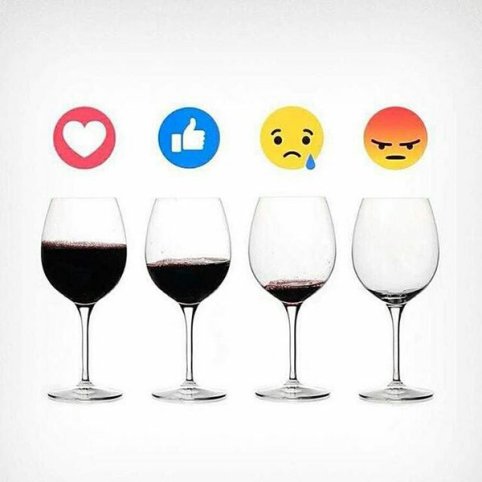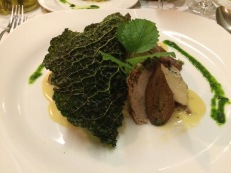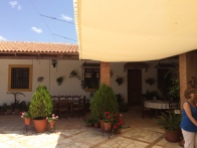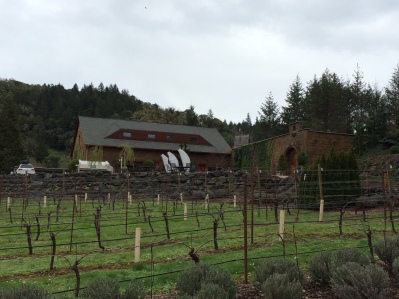- REFUSE TO BE INTIMIDATED. The world of wine is populated with a few, well, snobs. There are people whose income depends on you, the consumer, feeling like you don’t know enough to order a wine you will like. There are some whose income depends on getting you to buy a wine whether you like it or not. There are also few who want to make you feel uncomfortable just for their own ego gratification.
That said, there are also lots of folks who can and will help you feel more comfortable. These can include wine stewards or waiters in restaurants, employees in wine shops and at large retailers like Costco, tasting room employees, and, yes, wine bloggers like me. Take advantage of their knowledge and willingness to help. Even with the first group, you will usually find if you ask a couple of clear questions and let them know what you like and what you are willing to pay, you will get what you desire.
 2. BE AN EXPLORER. Try some unfamiliar wines. Even if after doing so, you become a drinker of one kind of wine, you will at least know that you aren’t missing something better for you. Again, wine retailers and restaurant employees can be helpful. Like Malbec? Try something close, like a Barbera or a Tempranillo. Traveling? Try the local wines. (LINK to my post WHAT KIND OF WINE DRINKER ARE YOU?)
2. BE AN EXPLORER. Try some unfamiliar wines. Even if after doing so, you become a drinker of one kind of wine, you will at least know that you aren’t missing something better for you. Again, wine retailers and restaurant employees can be helpful. Like Malbec? Try something close, like a Barbera or a Tempranillo. Traveling? Try the local wines. (LINK to my post WHAT KIND OF WINE DRINKER ARE YOU?)
3. AVOID REALLY CHEAP WINES. The issue here is not so much about price or quality as it is about additives. Most new world (that’s everyplace but Europe) wines under $10 to $15 are laced with additives of various kinds. There are no labeling requirements, so you don’t know which ones or how much of them are in your wine. Some additives are benign, some are not. Many people who eat only organic food buy cheap wines filled with chemical additives – unknowingly, of course. (LINK to my post on ADDITIVES)
There are three main reasons that cheaper wines have more additives than more expensive wines: One, consumers of cheaper wines tend to want their wine to taste the same every time. They are not interested in seasonal variation – the kind based on weather which affect wine grapes from just about everywhere. So, additives can mask changes – and in cheap wines, the issue is not seasonal variations; most are bulk wines, made from whatever grapes or juice are available at that moment from any location. Second – additives can make a rough product taste smoother, smell better, look better. In other words, mask problems. Third – there are economic reasons to use additives in some products, and your health is not one of them.
4. NEW TO WINE? TRY A STARTER CASE. I blogged about this a while back. If you are new to wine or have someone, like in my case, my daughter, who is new to wine, consider a starter case. This is a mixed case of wines for them to try to learn about. Then, when returning to the wine retailer, you or they can say what you liked and would like to get more of, or maybe explore a bit with something like what you enjoyed previously, but different. (LINK to my post on STARTER CASE)
5. LEARN HOW TO SHOP FOR WINE. I often go into wine shops without intending to make a purchase – just to look around, familiarize myself with the kinds of wines available, the labels, the price points. I may engage someone in the shop in a conversation about a specific wine, or a wine region that they feature. And, truth be told, much more often than not, I walk out with a bottle or three.
Many reputable wine writers and bloggers will tell you to ask questions when shopping for wine. Wine shop employees will generally enjoy helping you (with the possible exception of the Holiday rush). For example, you might ask for a wine in the $20 range to go with a lamb roast, or something to take as a special gift to a lover of Argentinian Malbec. (LINK to my post on SHOPPING FOR WINE)
6. LEARN HOW RESTAURANT WINE WORKS. There are a few things to be aware of when ordering wine in a restaurant. One is the pricing structure. The norm is to mark up a bottle two to two-and-a-half times retail cost. Many restaurants are offering wines at a lower mark-up (in Europe it is often the same as in a wine shop). Wine is a significant part of the profit structure at many restaurants. For others, it is an afterthought; the wines may not even go with the food offered.
There are myths about ordering wine in restaurants. Most are false or only partly true. The reality is that if wine is a serious consideration in a restaurant, the wine list will have been chosen with care based on what is important to that restaurant’s management. It might be by region – focusing on Italian wines in an Italian restaurant; or by type of food served – an emphasis on white and rosé wines in a seafood restaurant; or it may be wines selected for the specific items on the menu. Some say that the best buy is the 2nd cheapest wine on the list. This is almost never true. If it is good value you are seeking, a good choice is to order a bottle of one of the wines they are selling by the glass. These wines are usually a good value and they are sold by the glass because they are well-received.
Again, don’t be afraid to ask the waiter, wine steward, or sommelier for guidance – and DON’T forget to give him or her your budget! I have never had a negative experience with wine in a restaurant when I have been given guidance (I don’t always ask for it). (LINK to my post on ORDERING WINE IN A RESTAURANT)

7. REMEMBER CORKAGE. In many places, you can bring your own wine to a restaurant. Normally, a corkage fee will be charged, to cover the cost of using the glasses and having the wine open and served by the restaurant staff. This is a good option if you have a special bottle to share with family or friends that will go well with the restaurant meal. Some etiquette – if you don’t know, check in advance on the corkage policy of the restaurant; don’t bring a wine the restaurant has on its wine list; don’t pay $20 corkage on an $8 bottle of Yellow Tail to save money. And, if the wine is corked or otherwise bad, don’t try to send it back for another bottle! (LINK to my post about corkage)
8. LIFE IS TOO SHORT TO DRINK BAD WINE. I know you have a budget, which, like mine, is limited. And maybe you don’t have an educated palate to justify really expensive wine. However, as I noted above, just about all of the really cheap wines are filled with additives and are bad for you. So, think about how much wine you drink and what it would take to get the average cost per bottle up to $15 or more. At that price point, generally speaking you are drinking wine, not just a mixture of random grapes made in bulk. You will notice qualities like minerality, or terroir – the effect of the soil on the wine. You will begin to tell varietals apart ($7 Cabernet Sauvignon tastes surprisingly like $7 Merlot). And you will be drinking a more healthful beverage.
Also, if you buy a decent bottle and it’s bad (corked or chemical tasting for example), don’t drink it! Pour it down the sink, or if it’s not too bad, save it for cooking. If you get a bad bottle (meaning there is a flaw of some kind) at a restaurant, let the staff know. They should replace it. If they disagree with you, let them know that you may not be an expert, but you find the wine undrinkable. They should replace it with another bottle. If the first one was bad, you will taste the difference in the new bottle. It is bad form to ask for a different wine in this situation. Maybe you will get lucky and that will have been their last bottle of that kind in stock! (LINK to my post on EXPENSIVE WINES)
9. WINE ENJOYMENT IS SUBJECTIVE. No matter what the experts tell you, for 95% of wine consumers – the ones who haven’t trained their palates for years and taken rigorous certification classes – wine enjoyment is subjective. You either like a wine, have a “meh” reaction, or don’t like it at all. Robert Parker can’t tell you if you will like a wine. I try to look at tasting notes only after I have tasted a wine, to see if they got it right for me. There are things to know about specific wines, but, let’s be realistic, most who drink wine will never invest the time and energy to learn more than a few of them.
Wes Hagen, currently of Central California’s J. Wilkes Wines (LINK), shares his way to taste wine for most consumers:
Swirl the wine in the glass and look at the color; put your nose to the glass and sniff the bouquet; if it smells like something you want to put into your mouth, take a sip; if it tastes like something you want to swallow, swallow it; notice the finish.
If you begin from there and add some knowledge as you go, you will never get to a point where Wes’s advice doesn’t hold true.

10. HAVE FUN WITH WINE. Wine is both a beverage and, for some, a lifestyle. I love sharing a good bottle with friends and family, and almost never have an expensive (say over $30) bottle when alone. Dorianne and I used to have wine dinners, where we would ask our guests to bring a special bottle, like the one they’ve been saving for a special occasion for ten years, and a dish to accompany it. At the dinner, each guest will tell the story of their wine as everyone shares it. Or bring a bottle from a trip and share the story of the trip.
Go wine tasting when you travel near wine country – there are hundreds of “wine countries” these days. We have tasted in Mexico, Hungary, Poland, Ukraine, England, and in Michigan, Maryland, New York, Virginia, and Texas, to name a few outside of the normal wine destinations. You will meet some great people in the local wine industry, and fellow tasters are often interesting as well.
I am sure that there are other guidelines for enjoying wine. These are my top ten and I hope you find them of value!
Your comments are always welcomed.

Copyright 2018 – Jim Lockard


































































































 Shop
Shop 
















 hat is why we were so happy to discover Ristorante Italiano Epicuro (no website,
hat is why we were so happy to discover Ristorante Italiano Epicuro (no website, 




